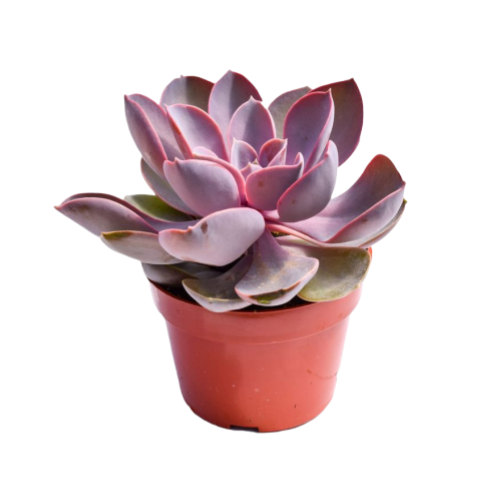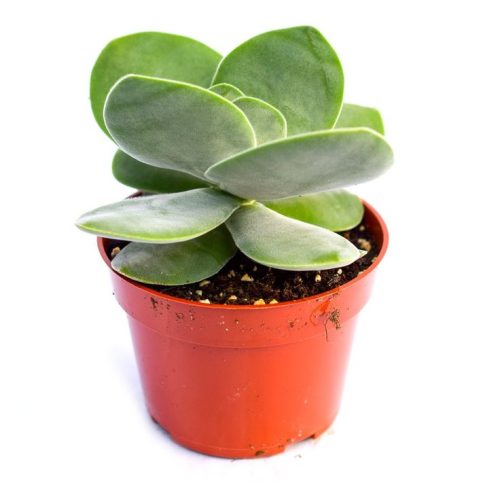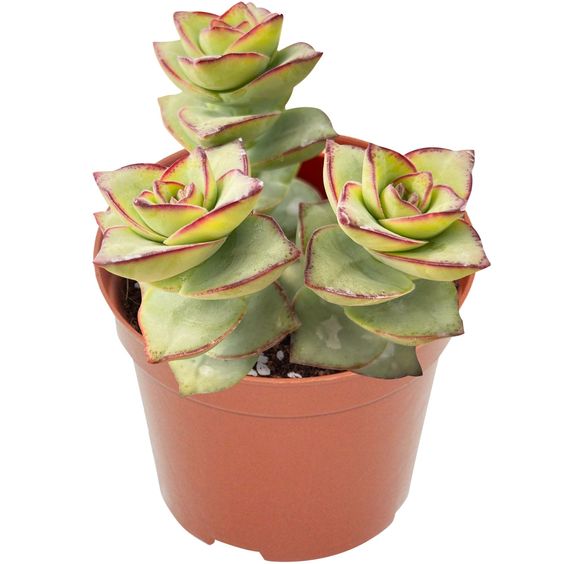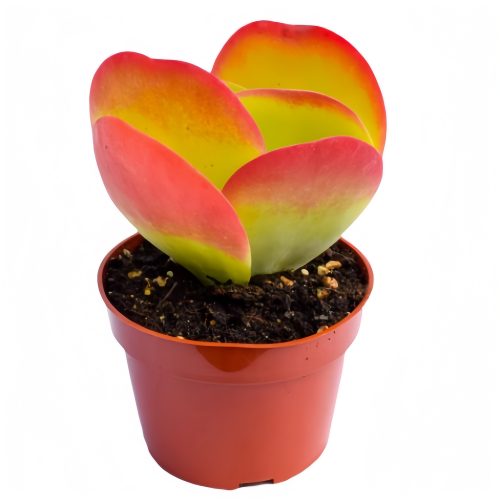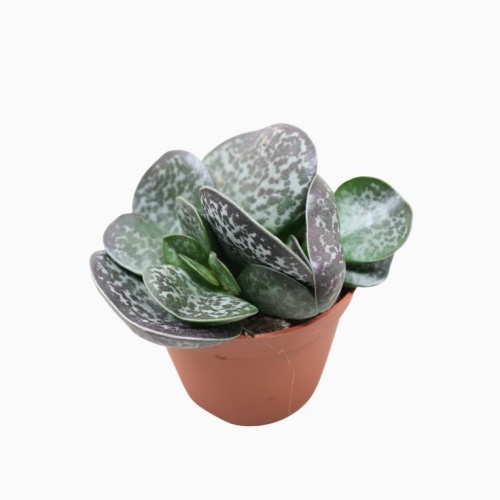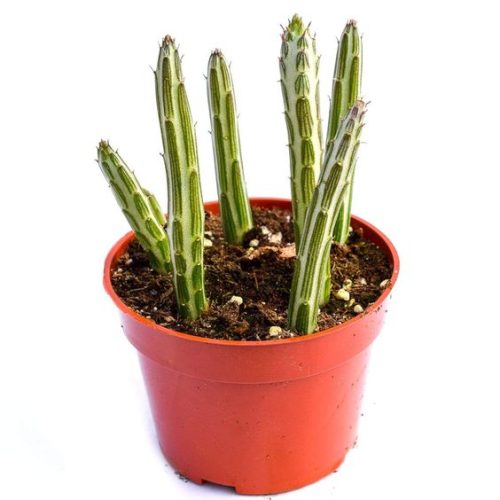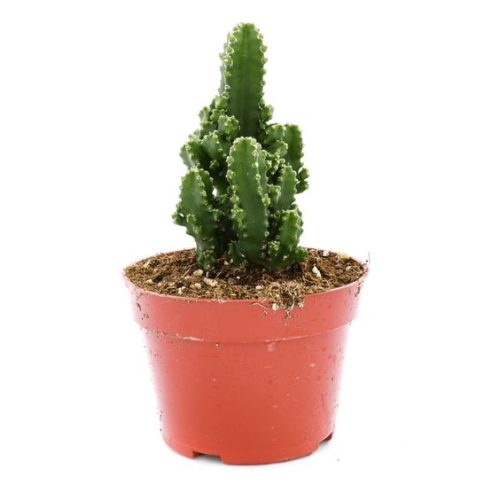ECHOAIA mgbe
Nlebazi anya
Nkọwa nke ngwaahịa
Echeveria Afterglow: The “Sunset Goddess” of Succulents, Beauty Beyond Compare!
Njiri mara nke osisi
Echeveria Afterglow (also known as “Sunset Glow”) stands out with its unique colors and elegant posture. The leaves are arranged in a rosette pattern, broad and spoon-shaped, with slightly wavy edges. They are covered with a thin layer of powder, transitioning from blue-green to purple-pink. When exposed to ample sunlight, the leaf edges turn a bright pink, resembling a stunning sunset. The plant has a compact form, with a height of about 15-20 cm and a diameter that can reach up to 30 cm. It blooms from spring to summer, with flower stalks emerging from the center, topped with bell-shaped flowers in shades of orange-red or pink, creating a striking contrast with the leaves and adding a touch of liveliness to the entire plant.
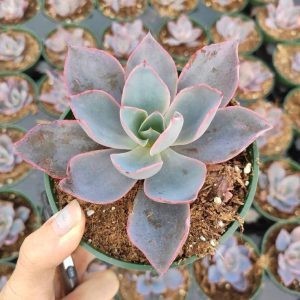
ECHOAIA mgbe
Usoro uto nke ehiaver
Echeveria Afterglow thrives in environments with plenty of sunlight, requiring at least six hours of direct sunlight daily. Insufficient light can cause the plant to stretch and lose its vibrant colors. It grows best in temperatures ranging from 15-25°C, tolerating heat but not cold. During winter, it should be kept above 5°C to avoid frost damage. The soil should be well-draining, preferably a mix of succulent-specific soil and porous materials like perlite or vermiculite to enhance aeration. Watering should follow the “soak and dry” principle, reducing frequency in summer and keeping the soil slightly dry in winter to prevent root rot. Fertilize with a diluted succulent-specific fertilizer once a month during the growing season, and stop fertilizing in winter.
Ngwa na njikọta nke Echaria Aflow
Echaaverria Eflow abughi naanị ihe ịchọ mma kamakwa ọ dị mma na ịchọ mma na njikọta. Dị ka ịchọ mma ime ụlọ, ọ zuru oke maka windowels, desks, ma ọ bụ mbara ihu, na-agbakwunye ikuku dị nro na nke ihunanya na-acha odo odo na-acha odo odo. Na ngwakọta ndị ọzọ, ọ na-ejikọta ya na ndị ọzọ dị ka Sedum ma ọ bụ Echaria, na-eke ihe ubi na-acha odo odo. Naanị ijide n'aka ịhọrọ osisi nwere ụdị ụdị uto ahụ. Enwere ike iji ya na nnukwu mgbidi, mmiri na-atọ ụtọ, ma ọ bụ na-akụ ya n'okirikiri, ebe ọ na-etolite mmetụta anya na-egosi mgbe a kụrụ ya na ụyọkọ, nke yiri anyanwụ dara anwụ na-asọ asọ. N'ihi ọdịdị ya pụrụ iche na ọdịdị dị mfe, ehiaria mgbe ọ na-enwe ezigbo onyinye maka ndị na-anụ ọkụ n'obi ma ọ bụ ndị mbido ịma mma, na-eziga echiche nke ịma mma na njikọ na okike.
Ntuziaka na-arụ ọrụ maka Echaaver
Iji hụ na uto dị mma na arịrịọ mara mma nke ECHOAIA mgbe, there are a few key points to keep in mind. First, watering is crucial. Echeveria Afterglow is drought-tolerant, so follow the “water only when dry, and water thoroughly” rule. Reduce watering frequency during the hot summer and cold winter when the plant grows slowly or goes dormant. Avoid watering directly onto the leaf center to prevent rot. Second, summer is a critical period for Echeveria Afterglow. When temperatures exceed 35°C, the plant may enter dormancy. Enhance ventilation and cooling measures, such as using fans or air conditioning, to lower the ambient temperature. Also, provide some shade to protect the leaves from scorching. Lastly, regularly clean the leaf surfaces to remove dust. The thin layer of powder on Echeveria Afterglow’s leaves not only enhances its beauty but also helps prevent pests and diseases. If you spot withered leaves or signs of pests, trim the affected parts and use disinfected tools to avoid spreading infections.
Nchịkọta nke Echaria Afterfow
Echaaverhia AfterGolow abụrụla kpakpando n'etiti mmiri n'ihi ụdị na agba pụrụ iche. Ọ bụ nnọọ ihe ọmụma nke ukwuu ma dị mfe ilekọta, na-eme ya nhọrọ dị mma maka ịchọ mma ụlọ, ogige, na inye onyinye. Ọ na-ahapụ ntụgharị site na acha anụnụ anụnụ na-acha odo odo na-acha odo odo, nke ifuru-acha ọbara ọbara, na-eke ọdịdị nke ịchọ mma nke ọma. N'ime ụlọ, ọ na-agbakwụnye ihe dị nro, metụ gị n'anya window windo, desks, ma ọ bụ mbara ihu ma ọ bụ mbara ihu. N'ogige, ụyọkọ nke Eikever mmiri n'okpuru anwụ dị ka ọdịda anyanwụ na-asọ asọ, na-adọrọ adọrọ ka ọ dị. N'ihi ọdịdị ya pụrụ iche na ọdịdị dị ala, ọ bụkwa onyinye dị mma maka ndị na-anụ ọkụ n'obi ma ọ bụ ndị na-akọ ugbo.





